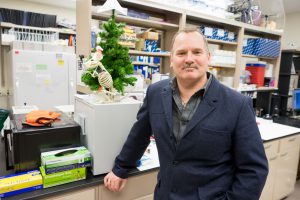As humans we are physically active. We walk. We run. We jump. We swim. From the time we can scoot along the floor and then toddle, we are movers.
The skeletal system, composed of tendons, ligaments, joints, and bones, is required for all of the movement that we do, each and every day.

Unfortunately, tens of millions of Americans experience skeletal-associated problems, and problems associated with the skeletal system only increase with aging. These can be acute problems, such as a bone fractures that result in immobilization for several months, or more chronic disabilities such as arthritis or osteoporosis.
Problems with bones and joints affect each and every one of us directly and indirectly every day. We watch as our grandmothers recover from broken hips, as our fathers develop arthritis, as our favorite players on our favorite sports teams are sidelined because of a fractured leg. Indeed, my wife and I are marathoners, and fight constant low-grade problems with our bones and joints, which we only hope will not develop into more serious, longer-term issues.
The research conducted in my laboratory by an outstanding team of undergraduate and graduate students, as well as PhD and veterinarian postdoctoral fellows, is focused on the bone. We are pursuing new knowledge to understand how bone forms. Our end goal is to develop treatments to accelerate fracture repair and to build bone mass for osteoporosis.
Worldwide, osteoporosis causes over 8.9 million fractures annually: 1 every 3 seconds.
Our research is funded through the National Institutes of Health and from the Congressionally Directed Medical Research Programs. Our approach to scientific inquiry is highly collaborative and we have a spectrum of expert collaborators from MSU as well as institutions around the country and the world.
In our research we are guided by the simple principle that future medicines and treatment approaches are founded in basic science discoveries. Indeed, through two newly awarded grants, we are pursuing novel treatment modalities to accelerate bone healing. We anticipate that within the next 3-5 years, this ongoing research will lead to cures that will be tested in human clinical trials.



